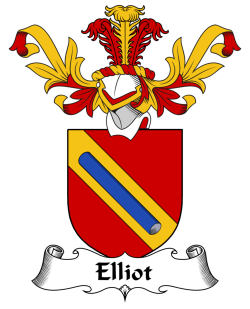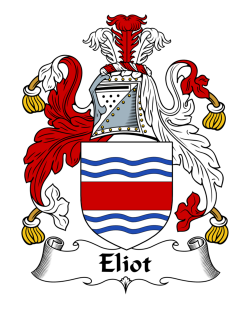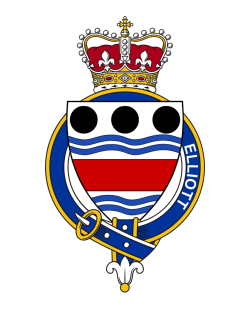
Clan Elliot
BOLDLY AND RIGHTLY
Although the Elliots originated from the Scottish Borders, it is believed that many clan members took their name from the village of Elliot near Forfar. It is believed that an 18th century fire destroyed many early records, and therefore the exact origins of the family are unknown. They first appear documented as a clan with a chief in place in the 15th century.
Like many other clans in the area, the Elliots were Border reivers and shared the territory of Liddesdale with clan Armstrong. The main family branch, the Elliots of Redheugh, were feared within the border area and regarded as the most troublesome of the reiver clans, along with the Armstrongs.
The Elliot clan motto is "Fortiter et recte" (With strength and right) and the clan crest is a raised fist holding a sword.
Scottish History
of Clan Elliot
The defenders
The Elliots were renowned as the wildest family in the whole of the brawling, turbulent Borderland – and that was no mean feat! Some historians claim the name comes from the Old English Elwald or Elwold, pronounced “Ellot”. However, a document of 1688 says, “The town of Elliot was their antiquitie, Which stands in Angus at the foot of Glenshie”. It is noteworthy that the modern town of Alyth on this site was in medieval times called Alight pronounced Ahl-lott. There was a Thomas de Alight recorded in 1296.
Whatever the source, by 1600 the phonetic spelling of the name had superseded all other forms. The modern spelling of “Elliot” came into use around 1650.
So how did an Angus family come to settle in the Borders? Unfortunately, virtually all their records were destroyed when the old castle of Stobs was burnt to the ground in 1712, and information about the beginning of the clan is sparse. According to tradition, the Elliots moved from Tayside to Upper Liddesdale in the Borders around 1320. Such a wholesale move is certainly exceptional, although another family did move at the same time from Gourdon in Berwickshire to become Gordons in Aberdeenshire. However, dramatic events were taking place.
In the years after Bannockburn, Robert the Bruce was consolidating his kingdom, revenging himself on traitors, and rewarding his followers. The feudal Lordship of Liddesdale, held for nearly two hundred years by the Norman de Soulis family, was forfeited for treason and given to Robert Bruce, the king’s illegitimate son.
Walter Alight of Brae in Angus had taken up arms in support of Bruce and thus it seems more than likely he and his people were rewarded with better land in Liddesdale. But more particularly, the King also ensured a strategic area of the Borders was strengthened by settling it with a loyal and warlike supporter.
Consisting of “twelve great families”, and under “a Baron of renown” i.e one who held a Charter to his lands directly from the King, the Elliots settled in Upper Liddesdale. However, it was an unusual situation for although they had a feudal overlord the Elliots still remained a clan, who owed immediate loyalty only to their chief.
There is a wide gap in the records between Walter Alight in 1306, and the first clear reference to an Elliot Chief which is found in a document dated 1476. This was Robert Ellot, 10th Chief, who built a peel tower on a cliff overlooking the ford on Hermitage Water near its junction with the Liddel. This looked across to the tower of Ellot of Park which guarded the other bank. Another 100 peel towers belonging to the Elliots were dotted up and down Upper Liddesdale, backed up by the grim and massive Hermitage Castle which dominated the main pass into England. They shared Liddesdale with the Armstrongs, another notorious family, and the story is told of a beggar seeking alms in a Border village without success. “Are there no Christians here?” he asked plaintively. Back came the reply “Na, we’s a’ Ellots and Armstrongs!”.
For three hundred years they suffered first in time of invasion. They counted their wealth in cattle for at the first alarm they buried their grain, burnt their houses and crops, and operated a scorched earth policy, leaving the invader nothing to feed off. The cattle were driven off by the boys into the depths of the forest which then covered much of the Borderland, while the men engaged in guerrilla warfare. It was the Elliots and Armstrongs who made the first resistance against the English invaders, and constantly harried them.
The Reivers
By force of habit the Elliots’ way of life in war became carried over into peace. There was little point in planting long term crops or building better houses when an invader could destroy them overnight. There was also little point in trying to settle down as peaceful farmers when at any moment they had to become Scotland’s shock troops yet again.
And so they became reivers, or professional cattle rustlers, who existed by a little light farming and spent the rest of the time plundering and raiding. They were superb guerrilla fighters, highly skilled in theft, raids, tracking and ambush and were described by a Spanish observer as the best light cavalry in Europe.
Bands of riders, sometimes 1,000 strong, clad in steel bonnets and leather jackets, armed with sword and lance, and mounted on tough, wiry, little horses, would ride into England on moonlit nights to pillage and rob, driving back stolen cattle through the twisting hill passes and morasses to Liddesdale.
But it wasn’t always Scots against the English. The Borders were more complex than that. Sometimes Scots helped English raiders, and sometimes Scot pillaged Scot. The reivers practised blackmail, kidnapping, terrorism, armed robbery and blood feuds, and these were as likely to be carried out by the chiefs as by the common folk.
They lived by jungle rules and trusted nobody except their own close kin. Yet they had a curious morality and respected their own unofficial laws. A Hot Trod, or hot pursuit, could be carried out within six days and the stolen goods recovered by force without fear of reprisal. There was little actual killing, except in a blood feud or where someone tried to stop them forcibly.
By the 16th century both English and Scottish governments tried to bring law and order into what was virtually a lawless state betwixt the two countries. The Borderland was divided into three administrative areas, each in charge of a Warden. The West March ran from Dumfries though Lockerbie to Eskdale; the Middle March covered Liddesdale and Teviotdale; and the East March took in the Eastern Borderland to Berwick. These were duplicated on the English side and the high Cheviot Hills divided them.
The Scottish Middle March was by far the most dangerous. By the 16th century it was inhabited by the wild, principal families of Kerr and Scott, and the lesser but no less dangerous families of Elliots, Armstrongs, Nixons, Pringles, Johnstons, and Turnbulls.
The Elliots somehow stand out from the other robber families for they seem possessed of a greater intelligence and were clannish to a degree. They fought at Flodden in 1513 under Robert Ellot, 13th of Redheugh, when King James IV invaded England in support of France. The King’s impetuosity in leading the Scots army down from a secure position on a hill top to attack the English army lost him his life. It also cost the lives of most of the Scottish nobility who died in a ring around him. Among the “Knyghtes and gentlemen slain” was “Maiyster Ellot”, the son of Robert of Redheugh.
It was a descendant of Robert’s, Jean Elliot of Minto, who wrote the haunting ballad about Flodden, “The Flowers of the Forest” –
I’ve heard them lilting, at the ewe milking.
Lasses a’lilting, before the dawn of day;
But now they are moaning, on ilka green loaning;
The flowers of the forest are a’ wede away.
The clan paid dearly, losing many of its fighting men, and it is said over 4000 acres of arable land in Liddesdale were left uncultivated.
Family History Mini Book
We hope you enjoyed reading this excerpt from this mini book on the Scottish history of the Elliot family.
You can buy the full book for only129 Clan Elliot
Tartan Products
The Crests
of Clan Elliot








































































